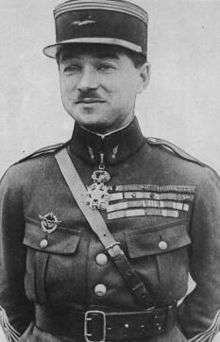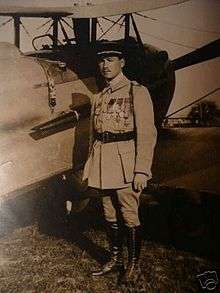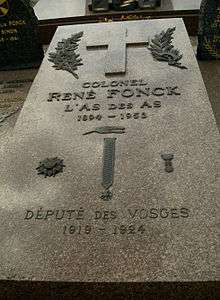René Fonck
| René Fonck | |
|---|---|
 René Fonck wearing the Légion d'honneur | |
| Birth name | René Paul Fonck |
| Born |
27 March 1894 Saulcy-sur-Meurthe, Vosges, France |
| Died |
18 June 1953 (aged 59) Paris, France |
| Allegiance |
|
| Service/branch | Infantry, French Air Service |
| Years of service |
1914–1918 1937–1940 |
| Rank | Colonel |
| Unit | C47, Spa103 |
| Awards |
Légion d'honneur Médaille militaire Croix de guerre Military Cross Military Medal Belgian Croix de guerre |
Colonel René Paul Fonck (27 March 1894 – 18 June 1953) was a French aviator who ended the First World War as the top Allied fighter ace, and when all succeeding aerial conflicts of the 20th and 21st centuries are also considered, Fonck still holds the title of "all-time Allied Ace of Aces". He received confirmation for 75 victories (72 solo and three shared)[1] out of 142 claims.[2] Taking into account his probable claims, Fonck's final tally could conceivably be nearer 100 or above.[3] He was made an Officer of the Legion of Honor in 1918 and later a Commander of the Legion of Honor after the war.
Early life
Fonck was born on 27 March 1894 in the village of Saulcy-sur-Meurthe in the Vosges region of north eastern France. During his formative years, he would have received an engineering education at Ecole Nationale Superieure des Arts et Metiers - a point that is still in debate since there is no record of this assertion. Fonck actually left school when he was 13.[4] Although he had been interested in aviation from his youth, he was rejected for immediate incorporation in the air service when conscripted on 22 August 1914, instead he was requested to undergo five months basic training in the combat engineers. His basic training duties involved him first in digging trenches near Épinal, and later in bridge repairs on the Moselle river.[5]
Military aviation career
1915–1916
On 15 February 1915 he was finally accepted into basic training to learn how to fly. He went into training at St. Cyr and then at Le Crotoy on a Blériot Penguin, a reduced-wingspan "flightless" version of the famous Blériot XI aircraft that gave the sensation of flying while still on the ground. He completed his pilot training in May 1915 and then flew Caudron G III[3] observation aircraft with Escadrille C 47.
On 25 May 1916 Fonck's observer was killed by an anti-aircraft shell burst, a fate that almost befell Fonck a few weeks later. Fonck claimed his first enemy aircraft in July 1916, but his victory was unconfirmed.
On 6 August, he attacked a German Rumpler C.III, and by maneuvering over and around the reconnaissance plane, staying out of its fields of fire, forced it lower and lower until the German crew landed behind French lines.[5] It was his first verified victory, though shared with his observer, Lieutenant Thiberge. It brought him the Médaille militaire in late August 1916.
1917
On 17 March 1917, Fonck scored the second time, downing an Albatros in conjunction with his observer, Sergeant Huffer. By this time, Fonck had amassed over 500 hours flight time, an incredible amount in those early days of aviation.
At age of 23, on 15 April 1917 ("Bloody April"), Fonck received a coveted invitation to join the famous Escadrille les Cigognes. Group de Combat 12, with its four escadrilles (or squadrons), was the world's first fighter wing. The leading French ace, Georges Guynemer, served at the time in one of its escadrilles, N3, and had just scored his 36th victory.
Fonck was assigned to another escadrille in the group, Spa 103.[3] Flying the SPAD VII,[3] he quickly made a name for himself, attaining flying ace status by 13 May. He picked off another target on 12 June, then went on hiatus until 9 August. He scored twice more in August, on the 21st and 22nd.
On the 14th, he killed the pilot of a German observation plane and watched as the plane inverted and dropped the thrashing observer almost through the wing of Fonck's Spad. He even went to the extreme of tearing the barograph out of the cockpit of that day's victim, his twelfth, so its readout would confirm his combat report. On 30 September, he and Adjutant Dupre jointly shot down a German two-seater. The news reported they killed pilot to be Leutnant Kurt Wissemann, who had allegedly shot down Guynemer, and that Fonck had boasted of avenging the death of his "good friend" Guynemer.[5] This story is put into question by German records, indicating that Kurt Wissemann of Jasta 3 had been killed two days before in a different fight,[6][7] in which he was flying a single-seater, probably against No. 56 Squadron.[8]
September and October had added four victories apiece to Fonck's score. Thus, by year's end, Fonck had raised his tally to nineteen,[9] had been commissioned as an officer, and had received the Légion d'honneur.
Fonck got only better. Known for his clinical professionalism, he applied mathematical principles to combat flying and his engineering knowledge regarding the capabilities of the aircraft he flew was unsurpassed among his fellow pilots. Fonck took few chances, patiently stalking his intended victims from higher altitudes. He then used deflection shooting with deadly accuracy on enemy pilots at close range, resulting in an astonishing economy of ammunition expended per kill. More often than not, a single burst of less than five rounds from his Vickers machine gun was sufficient. His preferred method of aerial combat was not to engage into dogfights, but to carry out surgically merciless executions. He was also reputed to be able to spot enemy observation aircraft from very far away, where most other pilots would have perceived nothing.
Fonck, like France's leading ace, Capt. Guynemer, flew a limited-production SPAD XII fighter, distinguished by the presence of a hand-loaded 37mm Puteaux cannon firing through the propeller boss. He is apparently credited with downing 11 German airplanes with this type of armament, called a "moteur-canon". This was made possible by the gear-reduction version of the Hispano-Suiza V8 SOHC engine first used in that model of SPAD fighter. It offset the now-hollow propeller shaft above the crankshaft axis, and the 37mm cannon was mounted in the V space between the two rows of cylinders. Fonck would later fly the highly successful SPAD XIII,[3] which was the first SPAD fighter model to use twin Vickers machine guns.
1918

He did not add to his tally sheet until 19 January 1918, when he scored a double victory. February added another five, March seven more, and another three in April.[9]
Then came a spectacular performance on 9 May. It was sparked by a disagreement between Fonck and two of his squadronmates, Edwin C. Parsons and Frank Baylies. Perturbed by Fonck's lectures on aerial success, the two Americans bet Fonck a bottle of champagne that one of them would shoot down an enemy plane before Fonck. Baylies took off despite hazy weather and shot down a Halberstadt CL.II. Back at the airfield, rather than pay off the bet, a sulky Fonck badgered the Americans to change the terms of the bet so that whoever shot down the most Germans that day would win. Lingering fog kept Fonck grounded most of the day. It was well into the afternoon before it cleared enough for him to take off at 1500 hours.[10] Between 1600 and 1605 hours, he shot down three enemy two-seater reconnaissance planes. A couple of hours later, he repeated the feat. Understanding the importance of reconnaissance planes, with their potential to direct intensive artillery fire onto French troops, Fonck concentrated his attentions upon them; six shot down within a three-hour span proved it.[9]
He added a double victory on 19 May and five more in June. By now, he was shooting doubles frequently, and with 49 on his score sheet, he was rapidly closing in on Guynemer's record.[9]
On 18 July 1918, he achieved another double, to bring his total to 53 and into a tie with Guynemer. The following day, he shot down three more enemy aircraft and surpassed the score of the legendary Guynemer, who had remained the leading French ace after his death on 11 September 1917.[9]
He added four more victories in August, raising his total to 60. Then, on 26 September, he repeated his feat of knocking down six enemy airplanes in a day, although this time three of his six victories were over Fokker D.VII fighters.[9][11]
Another success two days later and two on 5 October put his score at 69, very close to the 72 of Major William Avery Bishop, then the leading Allied ace. On 30 October, he matched Bishop with three more victories. He shot down two more the following day, and another the day after that, finishing with 75 confirmed victories.[9]
To summarize, he claimed 56 victories during the whole of 1918, attaining a total of 36 kills before May 1918. His 1918 list by itself would have made him France's leading ace. By the end of the war, he had accounted for all but 36 of Escadrille SPA.103's 111 claimed victories. Unlike many leading French aces, Fonck's score contained only three shared victories. Also unlike most aces, he remained unwounded; indeed, only a single enemy bullet had ever hit his aircraft.[5] He had also forgone the most hazardous air-to-air combat; he had shot down no balloons.
Yet for all his skill and success, Fonck never captured the heart of the French public as Guynemer had. Fonck was ascetic and withdrawn. Instead of drinking or socializing with the other pilots, he planned his flying missions and tactics, ironed his uniforms, and stayed physically fit through calisthenics. He seemed to overcompensate for his shyness by constantly mentioning his exploits. As a result, he seemed distant, arrogant, even abrasive. His comrades respected his skills, but even one of his few friends, Marcel Haegelen, considered him a braggart and shameless self-promoter.[5] Fonck may have resented the fact that Guynemer remained more popular in the French press even after he surpassed him in victories.. Fonck also seemed to lack insight into the effect his personality had upon his image or career.[12]
After the war

Fonck returned to civilian life after World War I, and published his war memoirs Mes Combats, prefaced by Marechal Foch, in 1920. The fame he got from the war allowed to be elected Member of Parliament representing the Vosges from 1919 to 1924.[13]
During the 1920s, Fonck persuaded Igor Sikorsky to redesign the Sikorsky S-35 for the transatlantic race or Orteig Prize.[14] On 21 September 1926, Fonck crashed on takeoff when the landing gear collapsed, killing two of his three crew members. Charles Lindbergh seven months later won the prize in 1927.
Fonck eventually returned to military aviation and rose to Inspector of French fighter forces from 1937 to 1939. His inter-war contact with the likes of former World War I foe Hermann Göring and Ernst Udet cast a shadow upon Fonck's reputation during the German occupation of France and led to allegations of collaboration with the Nazi occupying forces and the Vichy regime. On 10 August 1940, Vichy Foreign Minister Pierre Laval announced that Fonck had recruited 200 French pilots to fight on the Nazi side. However, the truth is more complicated.[15]
Marshal Philippe Pétain wished to use the Göring – Fonck relationship in order to meet Adolf Hitler and thus gave Colonel Fonck the order to talk to Göring. A meeting was planned at Montoire but after discovering evidence about the pro-Nazi politics of Pierre Laval, Fonck tried to convince Pétain not to attend. Initially Pétain appeared to heed Fonck's advice, but for some reason Pétain eventually decided not to follow Fonck's warnings and he met Hitler at Montoire on 24 October 1940. Fonck's loyalties were thus questioned by the Vichy regime, and thus he returned home to Paris where he was eventually arrested by the Gestapo and imprisoned in Drancy internment camp.[15]
After the war, a French police inquiry about his supposed collaboration with the Vichy regime completely cleared Fonck. The conclusion was that his loyalty was proved by his close contacts with recognised resistance leaders such as Alfred Heurtaux during the war.[15]
Additionally, he was awarded the Certificate of Resistance in 1948. Citation reads "Mr. Fonck, René, a member of the fighting French forces without uniform, took part, in territory occupied by the enemy, to glorious fights for the liberation of the nation".
Fonck remained in Paris but also visited frequently his native Lorraine where he had business interests. He died from a fatal stroke in his Paris apartment, Rue du Cirque, at the age of 59 and is buried in the cemetery of his native village of Saulcy-sur-Meurthe.
Quotes
- "I put my bullets into the target as if I placed them there by hand."[9]
- "I prefer to fly alone... when alone, I perform those little coups of audacity which amuse me..."[9]
Citations
Médaille militaire
"A pilot of remarkable bravery and skill, having already engaged in a great number of aerial combats. On 6 August 1916, he resolutely attacked two strongly armed enemy planes, took on one in pursuit, and by a series of bold and skillful maneuvers, forced it to land uninjured within our lines. He has been cited in orders twice."
Médaille militaire citation, 1916[9]
Légion d'honneur
"A fighting pilot of great value, combining outstanding bravery and exceptional qualities of skill and sang-froid. He came to pursuit aviation after 500 hours of flight on army corps aircraft and became, in a short time, one of the best French combat pilots. On 19, 20 and 21 August 1917, he shot down his 8th, 9th and 10th enemy aircraft. He has already been cited seven times in orders, and has received the Médaille militaire for feats of war."
Légion d'honneur citation, 1917[9]
Officier de la Légion d'honneur
"Remarkable officer from every point of view; of admirable fighting ardor. Pilot of the highest order, for reconnaissance missions and artillery range intelligence, as well as for surveillance service that he completed many times despite very unfavorable atmospheric conditions. He demonstrated, during the course of an uninterrupted series of aerial combats, an exceptional strength and will to win, which sets an example for the French chasse pilots of today. Has downed thirty six enemy planes. Seventeen citations, Médaille militaire and Chevalier de la Légion d'honneur for feats of war."
Officier de la Légion d'honneur citation, 12 May 1918[9]
Rene Fonck was also awarded the British Military Cross and the British Distinguished Conduct Medal.
See also
- Ivan Kozhedub, the World War II "Allied Ace of Aces" with 62 aerial victories over opposing aircraft
- List of World War I flying aces
- List of people on the cover of Time Magazine: 1920s – 23 Aug. 1926
Notes
- ↑ 'Over the Front', N. Franks & F. Bailey, Grub Street, 1992
- ↑ Victoires confirmées et probables du Ltt René FONCK
- 1 2 3 4 5 Lawson, Eric; Lawson, Jane (1996). The first air campaign, August 1914 – November 1918. Cambridge, Massachusetts: Da Capo Press. p. 205. ISBN 0-306-81213-4.
- ↑ Accoulon, Damien (2015). René Fonck (1894-1953), l'As des As. Mythe et oubli. Nanterre: Université Paris-Nanterre. p. 49.
- 1 2 3 4 5 http://www.acepilots.com/wwi/fr_fonck.html
- ↑ Guttman, Jon (2004-11-11). "Groupe de Combat 12, 'Les Cigognes'": France's Ace Fighter Group in World War 1. ISBN 9781841767536.
- ↑ "Who killed Guynemer".
- ↑ 'Above the Lines', Franks, Bailey & Guest page 232
- 1 2 3 4 5 6 7 8 9 10 11 12 The Aerodrome (1997). "René Fonck". Theaerodrome.com. Retrieved 21 November 2011.
- ↑ SPAD XII/XIII aces of World War I. p. 16.
- ↑ SPAD XII/XIII aces of World War I. p. 19.
- ↑ SPAD XII/XIII aces of World War I. pp. 16, 20.
- ↑ Accoulon, Damien (2015). René Fonck (1894-1953), l'As des As. Mythe et oubli. Nanterre: Université Paris-Nanterre. pp. 98–118.
- ↑ "S-35". Time. 23 August 1926. Retrieved 14 April 2007.
- 1 2 3 "René Fonck, L'As des l'As, L'homme", by Corrine Micelli, 2007, Editions Economica, Paris, France.
References/external links
Books written by René Fonck
- Fonck, René (1920). Mes combats. Paris: Flammarion.
- Fonck, René (1924). L'Aviation et la sécurité française. Paris: Brossard.
- Fonck, René (1967). Ace of Aces. New York: Ace Books Inc.
History books on René Fonck
- Accoulon, Damien (2015). René Fonck (1894-1953), l'As des As. Mythe et oubli. Nanterre: Université Paris-Nanterre.
- de Gmeline, Patrick (2011). Baron rouge et cigogne blanche. Paris: Presses de la cité. ISBN 978-2-258-08601-2.
- Micelli, Corinne; Palmieri, Bernard (2007). René Fonck: l'As des As, l'homme. Paris: ISC-Economica. ISBN 978-2-7178-5413-8.
Other related books
- Over the Front, N. Franks & F. Bailey, Grub Street, 1992
- SPAD XII/XIII Aces of World War I. Jon Guttman. Osprey Publishing, 2002. ISBN 9781841763163.
Related websites
- http://www.theaerodrome.com/aces/france/fonck.php Accessed 8 September 2008.
- http://www.acepilots.com/wwi/fr_fonck.html Accessed 9 September 2008.
- http://www.wwiaviation.com/aces/ace_Fonck.shtml Accessed 9 September 2008.
- http://www.firstworldwar.com/bio/fonck.htm Accessed 9 September 2008.
- http://everything2.com/title/Ren%25E9%2520Paul%2520Fonck Accessed 9 September 2008.
External links
| Wikimedia Commons has media related to René Fonck. |